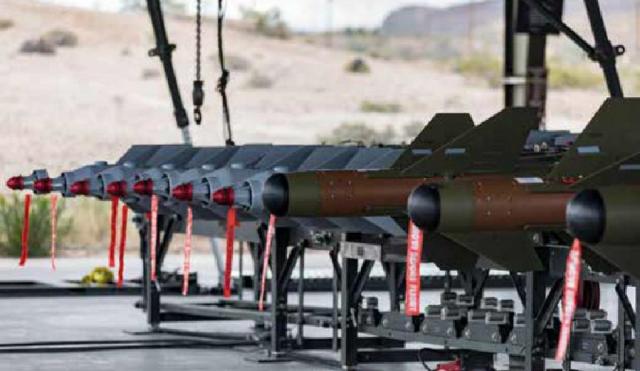Precision guided aerial bombs (UAB, also effectors in Western terminology) have had a decisive impact on the use of military aviation against ground targets. According to Western experts, with the current and planned composition of weapons, the Air Force receives a wide range of effectors that guarantee the necessary accuracy and are able to have a scalable effect on the properties of the target.
The main requirements for modern aviation weapons are accuracy and flexibility. They stem from increasingly complex combat scenarios. At the same time, the range of likely targets extends from stationary, such as fortified bunkers, to mobile, such as military vehicles or even boats and ships.
The potential capabilities of the Air Force to attack a ground enemy should be used with high accuracy, in all weather conditions, day and night, avoiding collateral damage and guaranteeing the security of its forces on the ground. It is obvious that the accuracy required for this can only be achieved by using high-precision guided weapons.
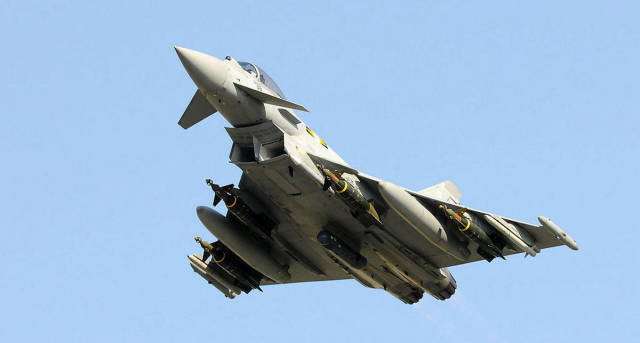
Eurofighter with GBU bombs, Litening III module and TB
Guided aerial bombs – guidance methods
The available range of precision guided munitions is diverse and distributed across different range classes. The Air Force has, among other things, GBU (Guided Bomb Unit, Russian – guided aerial bomb) with a range of up to 25 km.
The basis of the GBU is the body of an unguided bomb, which, with the help of appropriate sensor equipment and controls, is transformed into a controlled effector. At the same time, the guidance methods are mainly divided into two classes: UAB with pure laser guidance (Laser Guided Bomb, LGB) and UAB with GPS and inertial navigation (Joint Direct Attack Munition, JDAM, rus. – a single high-precision impact munition).
Laser guidance
The use of LGB is based on the illumination of the target with a laser beam. At the same time, the energy reflected from the target is recorded and processed by a sensor mounted on the effector. The included control unit on the bomb during the fall allows you to adjust the trajectory and accurately direct it to the target. This can be, for example, a certain floor of a building or a moving target tracked by a laser.
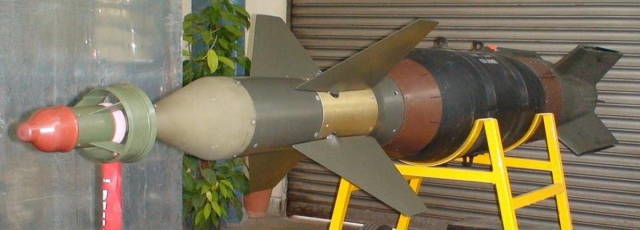
UAB with laser guidance system
At the same time, illumination is carried out either by means of a device placed on a flying platform, or by a mobile designator located on the ground. In this case, it is not necessary to know the exact location of the target in advance, nor that the target remains stationary when hit. Laser illumination allows you to achieve the highest possible accuracy and flexibility. However, it requires a line of sight between the illumination device, the sensors of the weapon and the target, that is, they are dependent on the prevailing weather and environmental conditions.
High-precision impact ammunition
This is exactly what led to the development of JDAM-type guided aerial bombs. The JDAM effector searches for its target from a high altitude using a combination of Inertial Navigation System (INS) and GPS guidance. At the same time, accuracy does not depend on weather conditions and environmental features, since it is achieved by knowing the exact coordinates of the ammunition and the target. The coordinates of the target are either scouted and specified in advance, or can be measured using in-flight targeting modules.
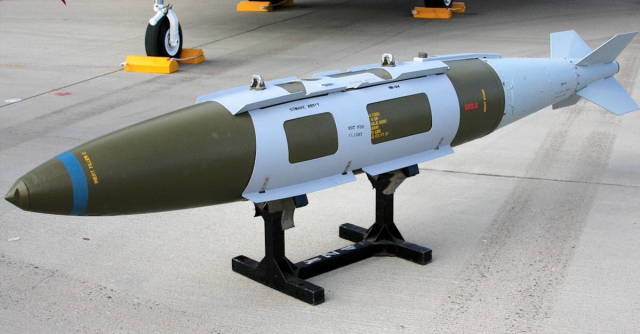
GBU-38 guided aircraft bomb type JDAM
With regard to guided aircraft bombs of the JDAM type, we are also talking about the so-called weapons operating on the principle of "shot – forgot". The principle allows the flying platform to leave the target area immediately after dropping the ammunition. In the case of dropping several ammunition, each effector can be assigned its own target, which ensures the defeat of a group of targets in one go.
In order to use the advantages of each guidance method and minimize its disadvantages, the so-called dual-channel guidance options (Dual-Mode-Varianten) have been developed for both LGB and JDAM. In this case, elements of either GPS /INS or LGB are added to the main guidance system of the corresponding class, thereby combining the capabilities of both systems.
Arsenal of guided aerial bombs of the Luftwaffe
In service German Air Force multipurpose platforms "html" target="_blank" rel="nofollow">Eurofighter Typhoon (Eurofighter) and Tornado (Tornado) when acting as fighter-bombers use a fairly wide arsenal of guided aerial bombs. The variety of possible ground targets and their diverse nature require from this category of effectors not only accuracy, but also the achievement of a predetermined effect on the enemy.
According to experts, Eurofighter, after the integration of the GBU-48 guided aerial bomb, which began at the end of 2017, has already reached the possibility of being used as an all-weather fighter-bomber (Fighter Bomber All Weather, FBX).
The GBU-48 multi-purpose high-precision all-weather bomb with laser and GPS guidance is manufactured on the basis of the Mk83 ammunition (1000 lb caliber, about 454 kg) by Raytheon. The ammunition has been in operation for a long time by the US Air Force and other NATO countries. Delivery to the Bundeswehr began in 2017 .
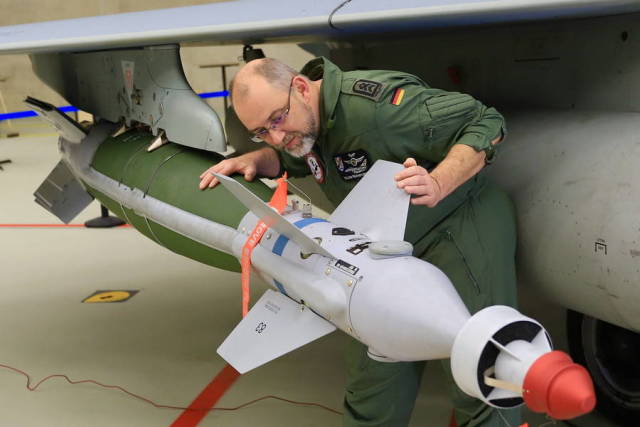
GBU-48 Guided Aerial Bomb
The system consists of the Mk83 bomb body, manufactured specifically according to German requirements, a programmable bomb detonator of the FBM21GER type (Fusee de Bombe Modulaire) and an improved Enhanced PavewayII control system. The control complex includes guidance equipment located in the head of the ammunition, as well as a group of rudders in its tail.
All-weather and accuracy are achieved by GPS-driven inertial navigation platform and laser homing head. The settings of the FBM 21GER detonator can be changed in the air, from the cockpit, which gives a significant gain in flexibility and allows the pilot to adapt the mission to a short-term change in the situation.
In the interests of delivering high-precision strikes on protected targets with minimal side effect, the Bundeswehr acquired the so-called "Trojan Improved Disruptor" (Trojan Improved Penetrator, TIP). The ammunition is a standard shell of the Mk 83 bomb, which has an improved penetrating ability. Matching the TIP dimensions to the Mk 83 bomb body allows the GBU-48 guidance and control system to be used, which ensures the fastest possible integration of the GBU-48TIP active ammunition into the Eurofighter system. Delivery also began in 2017.
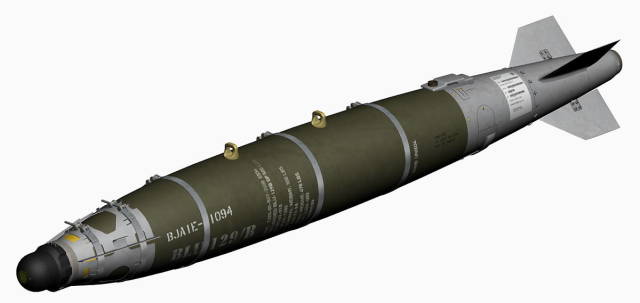
GBU-24 Guided Aerial Bomb
The use of the Tornado aircraft in the role of an all-weather fighter-bomber is ensured by the integration of GBU-54 and GBU-24 guided aerial bombs. The GBU-54 effector is manufactured by the Boeing concern on the basis of the MK-82 bomb (caliber 500 pounds, 226 kg). The dual-channel guidance system combines the classic JDAM ammunition with a laser homing head (homing).
It is believed that the product is particularly suitable for providing direct aviation support. A distinctive feature of the GBU-54 is its effectiveness against moving targets. Under the designation GBU-38, the effector is also available for use as a pure JDAM munition without a laser GOS. Its integration with Eurofighter is planned.
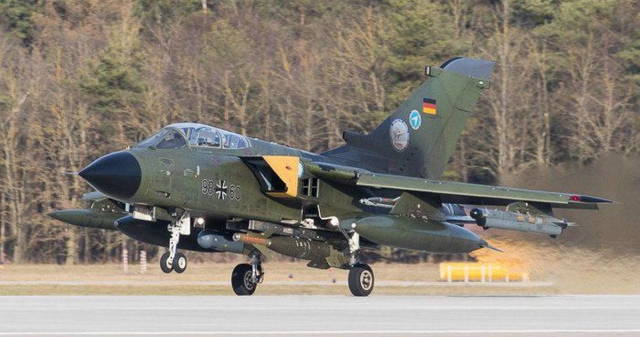
Tornado fighter-bomber with GBU-24
To cover categories of targets requiring high-power ammunition, the German Air Force is armed with GBU-24. As noted above, the ammunition is integrated with the Tornado fighter. The product is based on the MK 84 bomb (caliber 2000 pounds, 907 kg). At the same time, we are talking about pure laser-guided ammunition of the Paveway III series. Alternatively, it allows equipping with a BLU-109 penetrating core bomb. This effector gives an additional ability to break through particularly strong armor or penetrate through very thick concrete walls.
Thus, according to the estimates of the German Air Force Command, the current variety of high-precision guided aerial bombs allows the Luftwaffe to act accurately and consistently in complex operational scenarios. The basis for future purchases should be medium-range effectors, which will significantly complement the existing arsenal of the Air Force, adapting it to future challenges.
Based on the materials of the journal "Europäische Sicherheit & Technik"
